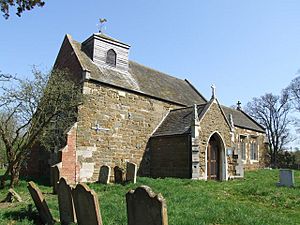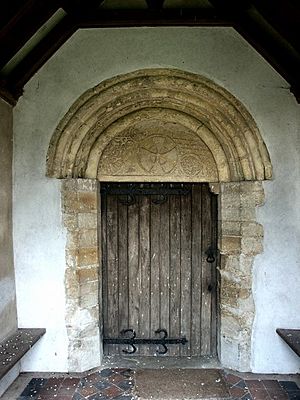St Benedict's Church, Haltham-on-Bain facts for kids
Quick facts for kids St Benedict's Church, Haltham-on-Bain |
|
|---|---|

St Benedict's Church, Haltham-on-Bain, from the southwest
|
|
| Lua error in Module:Location_map at line 420: attempt to index field 'wikibase' (a nil value). | |
| OS grid reference | TF 246 638 |
| Location | Haltham-on-Bain, Lincolnshire |
| Country | England |
| Denomination | Anglican |
| Website | Churches Conservation Trust |
| History | |
| Dedication | Saint Benedict |
| Architecture | |
| Functional status | Redundant |
| Heritage designation | Grade I |
| Designated | 14 September 1966 |
| Architectural type | Church |
| Style | Norman, Gothic |
| Specifications | |
| Materials | Greenstone with limestone dressings and some red brick. Roofs slated |
St Benedict's Church is an old Anglican church in Haltham-on-Bain, a village in Lincolnshire, England. It's a very important historical building, listed as Grade I, and is looked after by the Churches Conservation Trust. You can find it between the River Bain and the A153 road, which connects Horncastle and Coningsby.
Contents
History of St Benedict's Church
This church was built a very long time ago, in the early 1100s. Over the years, especially in the 1200s, 1300s, and 1400s, parts of it were changed and new sections were added. In 1842, people said it was "an ancient structure" that had "suffered much from the hand of time." This means it was very old and a bit worn out.
The church was repaired and updated in 1880 and again in 1891. The 1891 repairs even made space for more people, increasing the seating from 67 to 140. In October 1977, the church was no longer used for regular services, which is why it's called a "redundant church."
Church Architecture and Design

St Benedict's Church is built from a type of stone called greensand, mixed with limestone for the decorative parts. Some areas have been repaired with red brick. The roofs are made of slate, and the small tower where the bell hangs, called a bellcote, is covered with wooden boards.
Outside the Church
The church has a main area called the nave, a side section on the north called an aisle, and a porch on the south side. The bellcote sits near the front of the nave roof. At the very front of the church, there's a doorway from the 1300s. Above it is a window from the 1400s with three sections. You can also see two old stone carvings of heads, probably from the Middle Ages.
The north aisle has a few windows and a doorway that is now blocked up. The east window is very pretty, with four sections and Decorated style patterns. The south side of the nave has a window from the 1200s. The south porch, built in the 1300s, has an arched entrance and decorative stone supports called buttresses. The inner doorway is in the Norman style, with a round top and fancy carvings. Above this inner door, there's a carved stone panel called a tympanum. It shows a Maltese cross inside a circle, a shell shape, and a knot design.
Inside the Church
Inside, the main area (nave) and the north aisle are separated by an arcade, which is a row of arches supported by columns. Two of these arches are rounded, from the late 1100s. The arch closest to the front is pointed, likely from the 1200s. The arch leading into the chancel (the part of the church where the altar is) is pointed and from the 1800s.
In the chancel, there's a piscina from the 1300s, which is a basin used for washing sacred vessels. It has two pointed arches. You can also see four brackets that once held statues and a small cupboard called an aumbry. The pulpit, where sermons are given, is from the 1700s. Above it is a wooden canopy called a sounding board. Around the pulpit, there are old wooden seats, some of which are "family pews" rebuilt using wood from a screen from the 1400s.
The font, used for baptisms, is shaped like an octagon and dates from the 1300s. Its bowl is carved with flower-like designs called fleurons. You can also see painted boards inside the church with the royal arms of King Charles I and verses from the Bible.
Outside the Church Grounds
In the churchyard, there is a stone cross from the 1300s. It has an eight-sided shaft on a square base. This cross is also a protected historical item, listed as Grade II.
See also

